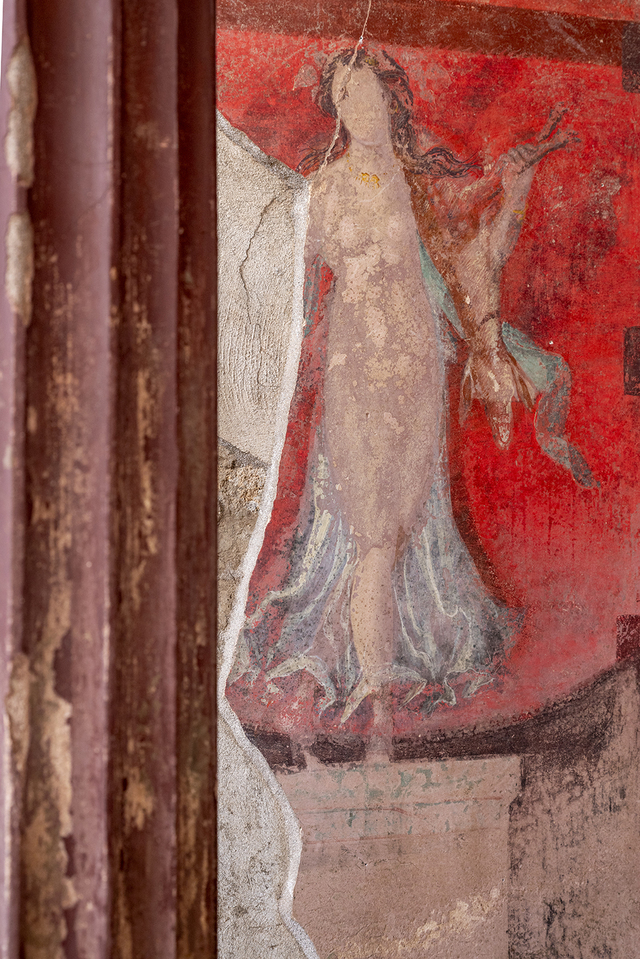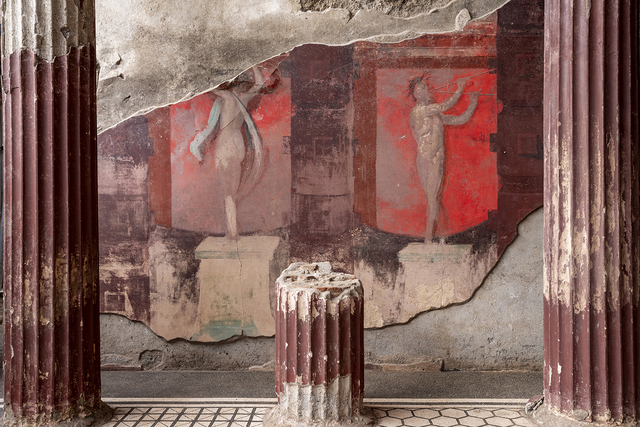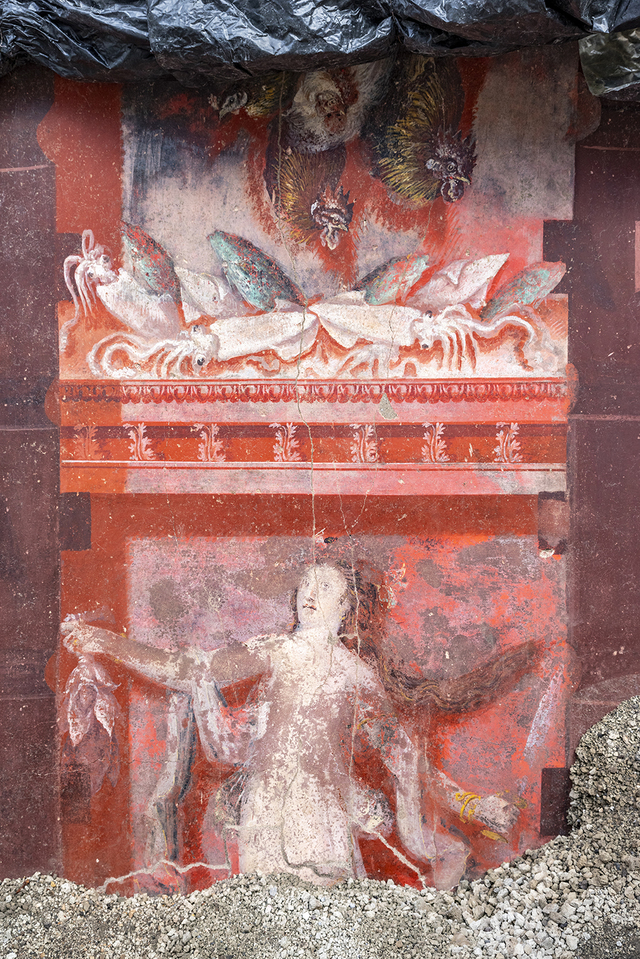The ruins of Pompeii continue to reveal secrets of the ancient world, offering glimpses into the lives, beliefs, and customs of a civilization frozen in time by the eruption of Mount Vesuvius. One of the most recent and fascinating discoveries within the ancient city is a rare Dionysian fresco, offering invaluable insights into the religious practices of the time, specifically the Dionysian cults. Found in the House of Thiasus, located in Region IX of Pompeii, this fresco is one of the most significant finds in over a century, providing a unique look at the rituals and mysteries of Dionysus, the god of wine and ecstasy.
The House of Thiasus: Discovery and Excavation
The fresco was uncovered in 2025 during ongoing excavations as part of the Castellation Regeneration project in Pompeii. The House of Thiasus, named after the retinue of Dionysus known as the “Thiasos,” is a significant Roman residence that was once a lively space used for social gatherings and religious practices. The house is located in Region IX, which has seen substantial archaeological activity in recent years, revealing many key elements of daily Roman life.

The fresco was found in the banquet hall, a central room where residents likely hosted important social events. The excavation team led by the Archaeological Park of Pompeii was surprised by the level of preservation and the detail of the artwork. The fresco covers three walls of the banquet hall, depicting an elaborate procession for Dionysus. It is an example of “megalography,” a type of artwork characterized by large figures designed to cover extensive areas.
Video
Watch Pompeii’s Most Sensational Find in 100 Years in Regio IX Reveals Dionysus Frescoes to explore this incredible discovery of ancient art. A must-see for history enthusiasts!
The Fresco: Artistic Details and Themes
The fresco itself is a masterpiece of Roman wall painting. It presents an energetic and highly detailed depiction of the Dionysian procession, with several maenads—female followers of Dionysus—portrayed in a frenzy of ecstatic dancing and fierce hunting. The maenads, dressed in flowing garments, are shown carrying slaughtered goats on their shoulders, while also brandishing swords. Among them, young satyrs—mythological creatures with the lower bodies of goats—play music and take part in a ritual wine sacrifice.

At the center of this procession, an elderly Silenus, a companion of Dionysus, stands with a torch beside a young woman, who appears to be undergoing a secret initiation ritual. This imagery emphasizes the transformative and rebirth-like qualities associated with the Dionysian cult, where initiation was believed to allow followers to experience a form of spiritual resurrection.
The Dionysian Cult and Its Symbolism
The cult of Dionysus, originating from Greece, was deeply ingrained in Roman religious practices by the first century BCE. Dionysus was worshipped as the god of wine, ecstasy, and transformation, symbolizing the release from societal norms and the embrace of chaos and nature. The Dionysian mysteries promised its initiates a spiritual rebirth, often through ecstatic and ritualistic performances involving music, dance, and the consumption of wine.


The fresco in the House of Thiasus illustrates this process of transformation through its portrayal of the maenads and the ritualistic activities in which they engage. The maenads’ dual role as both dancers and hunters reflects the complex and dual nature of Dionysian worship, which celebrated both the wild and untamed aspects of life, as well as a controlled, ritualistic reverence for the god. The interplay between controlled domesticated figures and untamed followers—particularly the contrast between the controlled, domesticated woman and the wild, untamed bacchante—illustrates a religious and social dichotomy that was present in Roman society.
The Unique Features: Hunting and Rituals

One of the standout features of this fresco is its inclusion of hunting scenes. This is something not commonly seen in other depictions of Dionysian rituals, such as the famous Villa of the Mysteries fresco. Above the main procession, a smaller frieze further emphasizes the theme of hunting by depicting a variety of animals—both alive and freshly hunted. This frieze shows a gutted wild boar, a fawn, various birds, fish, and even shellfish, highlighting the connection between the hunt and Dionysian rites.
This integration of hunting into the Dionysian rituals may suggest a link between the practice of initiation and the pursuit of wild game. The chaos and unpredictability of the hunt seem to align with the transformative nature of the Dionysian experience, reinforcing the theme of transformation and the abandonment of social restraints. This unique feature also sets the fresco apart from other works depicting Dionysian rituals, making it a rare and significant discovery for archaeologists.
Cultural Significance and Social Context
The fresco from the House of Thiasus offers valuable insight into Roman social and religious practices. The banquet hall, as depicted in the fresco, was not only a space for dining but also for the performing of religious rites and rituals. The rituals associated with Dionysus allowed individuals to experience a release from societal norms, something that would have been both liberating and transgressive in Roman society.

Moreover, the fresco’s focus on the contrast between the controlled woman and the untamed bacchante reflects the complexities of gender roles and social expectations in ancient Rome. The figure of the initiate being welcomed into the Dionysian mysteries speaks to the intersections of gender, power, and religion during the period. The imagery of women at the heart of the ritual underscores their centrality in the religious practices of the time, challenging the patriarchal norms of Roman society.
Preservation Efforts and Public Access
The fresco, as part of the ongoing excavation at Pompeii, has been carefully preserved and is now open to the public as part of the Regio IX tours. Archaeologists have taken great care in preserving the fresco’s vivid colors and intricate details, ensuring that future generations can appreciate this remarkable glimpse into ancient Roman religious life.
The broader excavation of Region IX, which has uncovered several other key sites including workshops and homes, continues to provide valuable insights into Pompeii’s domestic and religious life. As the excavation team works to stabilize and preserve these findings, they plan for the permanent public access to these newly uncovered areas, allowing the public to engage directly with the history and culture of ancient Pompeii.

Conclusion: A Window into Ancient Rituals
The discovery of the Dionysian fresco in the House of Thiasus is a groundbreaking find in the study of ancient Roman religion. This vivid painting offers a rare glimpse into the Dionysian mystery cults and the complex, transformative rituals they performed. It not only enriches our understanding of Roman religious practices but also sheds light on the role of women and the social dynamics of the time.
As excavations continue, Pompeii remains a treasure trove of historical insights, with each new discovery offering further revelations about the people who lived, worshipped, and celebrated within its walls. The Dionysian fresco is a testament to the creativity, ritual, and cultural complexities of the ancient world, offering modern audiences a window into a society long gone, yet never truly forgotten.
Video
Watch A Day in Pompeii – Full-length Animation to experience the vibrant life and tragic destruction of Pompeii. An immersive journey back in time!



